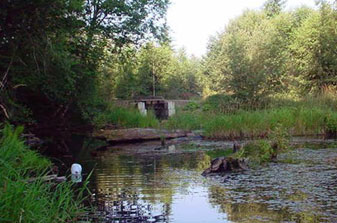Forest Roads Improvement Program Protects Water Quality and Fish Habitat
With the implementation of the Forests & Fish Law, forest
landowners are required to improve their forest roads to protect public
resources, including water, fish, and wildlife habitat. Improved road
maintenance and construction practices reduce or eliminate runoff and
sediment being delivered into streams, which can degrade water quality
and fish habitat.
The Law addresses this challenge through Road
Maintenance and Abandonment Plans, or
RMAPs.
These plans are outlined to properly abandon or stabilize existing
forest roads no longer in use and improve standards on how new roads
are to be built. So far, nearly 60,000 miles of roads have improved,
opening up almost 1,000 miles of stream habitat.
For example, one WFPA member, Merrill & Ring, was able to work
collaboratively with the nearby Lower Elwha tribe to come up with
funding to create new spawning areas for fish in the South Fork Pysht
River. The project included replacement of a culvert with a bridge,
construction of a channel to connect a pond with the river,
and placing large woody debris in the constructed channel and the
South Fork Pysht River.
Since project completion, adult salmon have been observed in
the new channel and hundreds of young salmon are seen in the pools
created by the large woody debris placement.

Near the river was a pond that had an overflow culvert under the road
which then drained into roadside ditches that eventually drained back
into the river. The collaborative group’s plan for restoration of
this area was to replace the culvert with a passageway that would
allow fish to reach the pond, and to construct a channel for fish use
while maintaining the ditches for road run-off.
One reason this project was considered of such importance was the
observation of adult salmon trying to swim through the ditches for
spawning. Part of the creative problem solving needed for this
project was how to create a passageway, that would be open during
high water, yet not get washed out, and not drain the pond. It was
decided that a small bridge placed over the road would be needed,
instead of a culvert.
To further improve the access to the pond,
a channel was dug out connecting to the river. Large woody debris
was placed in the stream. Previous work helped the Lower Elwha
S’Klallam crew decide where the most natural places for log jams
would be. These log jams at first appear to block the stream, but
a closer look shows numerous passages between, under, and around the
logs. These passages are large enough to permit the passage of
adult spawning salmon in the fall and provide hiding places for
the salmon fry, which helps them escape from predators.


